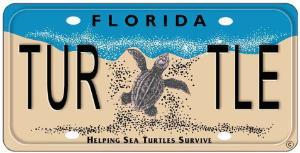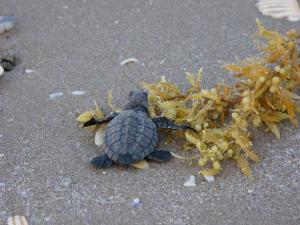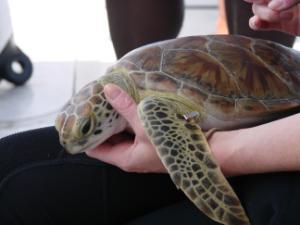5th Grade Sea Turtle Curriculum
This curriculum was designed in 2014-2016 by Drs. Maia McGuire and Ruth Francis-Floyd with assistance from Dr. Mark Flint and Jaylene Flint. The intent is to have 5th grade teachers in Florida (and elsewhere) integrate these lessons into their regular curriculum. Comments on the curriculum should be sent to Maia McGuire.
The curriculum consists of a book, One in a Thousand: Those Amazing Sea Turtles, with lesson plans to accompany each of the ten chapters. Teachers are free to download the book and either print it (85 pages) or make it available to students electronically (as a pdf file). The book can also be purchased in a printed version from the UF/IFAS Extension Bookstore (quantity discounts are available).
Each lesson contains a vocabulary list for the chapter, which is suggested for use as word wall words.
If you have used the book or any of these lessons, we'd love to get your feedback. Please take a few minutes to fill out a short online evaluation. Thanks! You might also like to know about our virtual field trips--the beach trip for middle school students includes content about sea turtles.
Description: Students will learn about the biology and ecology of sea turtles; they will learn ways that humans impact and can protect them.
Book: One in a Thousand: Those Amazing Sea Turtles (pdf 8 MB)
Lesson Plans:
Sea Turtle Curriculum overview (pdf 195 KB)
Lesson 1: Sea Turtle Biology.
- Students will learn about basic sea turtle biology.
- Video of Chapter 1 read by Dr. McGuire
- Sea turtle lesson 1-Sea Turtle Biology (206 KB pdf)
Lesson 2: How Do Scientists Identify Turtles?
- Students will learn about the characteristics of the seven species of sea turtles.
- Video of Chapter 2 read by Dr. McGuire
- Students will design their own dichotomous key to differentiate four different types of coins.
- Students will use a dichotomous key to identify a sea turtle that is assigned to them.
- Sea Turtle Lesson 2-How Do Scientists Identify Turtles (3.4 MB pdf)
Lesson 3: Sea Turtle Evolution and Anatomy.
- Video of Chapter 3 read by Dr. McGuire
- Students will design a timeline showing the relative timing of events in sea turtle history.
- Students will compare sea turtle and human anatomy.
- Sea Turtle Lesson 3-Sea Turtle Evolution and Anatomy (338 KB pdf)
Lesson 4: How Does the Environment Affect Sea Turtle Nests?
- Students will learn how storms and temperature can affect developing sea turtle embryos
- Video of Chapter 4 read by Dr. McGuire
- Sea Turtle Lesson 4-How Does the Environment Affect Sea Turtle Nests (412 KB pdf)
Lesson 5: Growing Up as a Sea Turtle.
- Students will learn about the range of natural threats to sea turtles during their entire life history (egg to adult).
- Video of Chapter 5 read by Dr. McGuire
- Students will apply their new knowledge by writing an "autobiography" from the point of view of a sea turtle.
- Sea Turtle Lesson 5-Growing Up as a Sea Turtle (5.3 MB pdf)
- Sea Turtle Lesson 5-Survival PowerPoint (32 MB pptx)
Lesson 6: How Do Human Activities Affect Sea Turtles?
- Students will learn about some of the many ways that human activities have impacted sea turtle populations worldwide.
- Video of Chapter 6 read by Dr. McGuire
- Sea Turtle Lesson 6-How Do Human Activities Affect Sea Turtles (286 KB pdf)
Lesson 7: Natural Threats to Sea Turtles.
- Students will learn about natural threats to sea turtles, including climate change and harmful algal blooms.
- Video of Chapter 7 read by Dr. McGuire
- Sea Turtle Lesson 7-Natural Threats to Sea Turtles (486 KB pdf)
Lesson 8: How Do We Protect Sea Turtles?
- Students will learn about laws that protect sea turtles, and ways that countries sometimes need to take special actions to help sea turtles survive.
- Video of Chapter 8 read by Dr. McGuire
- Sea Turtle Lesson 8-How Do We Protect Sea Turtles (293 KB pdf)
Lesson 9: Turtle Tracking.
- Students will learn how scientists track sea turtles' movements in the ocean.
- Video of Chapter 9 read by Dr. McGuire
- Sea Turtle Lesson 9-Turtle Tracking (219 KB pdf)
Lesson 10: Helping Sick or Injured Sea Turtles.
- Students will be able to understand that sea turtles can become sick and injured and that there are ways people can help them.
- Video of Chapter 10 read by Dr. McGuire
- Sea Turtle Lesson 10-Helping Sick or Injured Sea Turtles (274 KB pdf)
Dr. Maia McGuire is the Florida Sea Grant Associate Director for Extension and Education. Dr. Ruth Francis-Floyd is a UF/IFAS Extension veterinarian. Dr. Mark Flint is a veterinarian specializing in reptiles. Jaylene Flint is a sea turtle research biologist.




